KSEEB Class 11 Physics Solutions For Chapter 5 Motion Very Short Type Questions And Answers
Question 1. Why are spokes provided in a bicycle wheel?
Answer:
The spokes of the cycle wheel increase its moment of inertia. The greater the moment of inertia, the greater the opposition to any change in uniform rotational motion.
As a result, the cycle runs smoother and steadier. If the cycle wheel had no spokes, the cycle would be driven with jerks and hence unsafe.
Read and Learn More KSEEB Class 11 Physics Solutions
Question 2. What is inertia? What gives the measure of inertia?
Answer:
The inability of a body to change its state by itself is known as inertia. The mass of a body is a measure of its Inertia.
Types Of Inertia
- Inertia of rest
- Inertia of motion
- Inertia of direction.
Question 3. According to Newton’s third law, every force is accompanied by an equal and opposite force. How can a movement ever take place?
Answer:
From Newton’s third law action = -reaction. But action and reaction are not working on the same system. So they will not cancel each other. Hence, motion is possible.
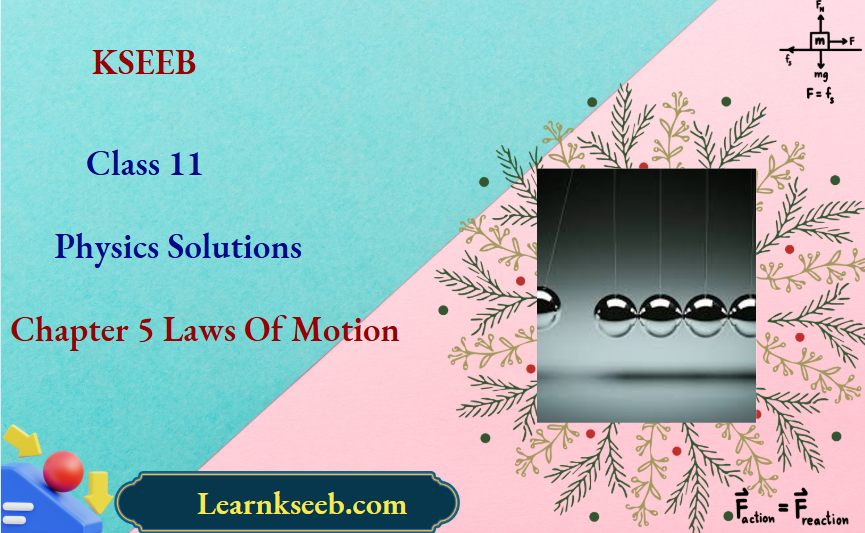
Question 4. When a bullet is fired from a gun, the gun gives a kick in the backward direction. Explain.
Answer:
The firing of a gun is due to Internal form. Terminal forces do not change The momentum of the system. Before firing m1u1 + m2u2 = 0.
Since the system is at rest after firing m1v1 + m2v2 = 0(or) m1v1 = – m2v2. So gun and bullet will move in opposite directions to satisfy the law of conservation of linear momentum.
KSEEB Class 11 Physics Chapter 5 Solutions PDF
Question 5. Why does a heavy rifle not recoil as strongly as a light rifle using the same cartridges?
Answer:
Velocity (or) recoil \(v=\frac{m v}{M}\) i.e., the ratio of momentum of the bullet to the mass of the gun. If the mass of the gun is high then the velocity of the recoil is less with the same cartridge.
Question 6. If a bomb at rest explodes into two pieces, the pieces must travel in opposite directions. Explain.
Answer:
Explosion is due to internal forces. From the law of conservation of linear momentum, internal forces cannot change the momentum of the system. So after explosion m1v1 + m2v2 = 0 or m1v1 = – m2v2. According to the law of conservation of linear momentum, they will fly in opposite directions.
Question 7. Define force. What are the basic forces in nature? Answer:
Force is that which changes (or) tries to change the state of a body.
The Basic Forces In Nature Are:
- Gravitational forces,
- Electromagnetic forces,
- Nuclear forces.
Question 8. Can the coefficient of friction be greater than one?
Answer:
Yes. Generally coefficient of friction between the surfaces is always less than one. But under some special conditions like on extremely rough surfaces coefficient of friction may be greater than one.
Question 9. Why does the car with a flat tire stop sooner than the one with inflated tires?
Answer:
Due to the flatting of tires, the frictional force increases. Because rolling frictional force between the surfaces Is proportional to the area of contact. Area of contact Increases for flattened tires. So rolling frictional force Increases and the car will be stopped quickly.
Question 10. A horse has to pull harder during the start of the motion than later. Explain.
Answer:
To start motion in a body we must apply force to overcome static friction(Fs = μsmg). When once motion is started between the bodies then kinetic frictional force comes into act.
Kinetic friction (Fk = μkmg) is always less than static friction. So it is tougher to start a body from rest than to keep it in. motion.
Question 11. What happens to the coefficient of friction if the weight of the body is doubled?
Answer:
When the weight of the body is doubled still then there is no change in coefficient of friction. Because frictional force oc normal reaction.
So when the weight of a body is doubled then frictional force and normal reaction will also become doubled and the coefficient of friction remains constant.
Laws Of Motion Solutions KSEEB Class 11 Physics Short Type Questions And Answers
Question 1. A stone of mass 0.1 kg is thrown vertically upwards. Give the magnitude and direction of the net force on the stone
- During its upward motion,
- During its downward motion,
- At the highest point, where it momentarily comes to rest.
Answer:
Mass of stone, m = 0. 1 kg.
1. During upward motion force acts downwards due to acceleration due to gravity.
Magnitude of force F = mg = 0.1 x 9.8 = 0.98 N(↓)
During downward motion force acts downward.
Magnitude of force F = mg = 0.1 x 9.8 = 0.98N(↓)
3. At the highest point velocity v = 0. Hut still g will act on it only In downward motion so resultant forceF = 0.98 N. downward.
Note: In the entire Journey of the body force due to gravitational pull acts only In a downward direction.
4. If the body is thrown with an angle of 30° with the horizontal then the vertical component of gravitational force does not change, hence in this case downward force F = mg = 0.1 x 9.8 = 0. 98 newton.
Question 2. Define the terms momentum and impulse. , State and explain the law of conservation of linear momentum. Give examples.
Answer:
Momentum \((\overline{\mathbf{p}})\): It is the product of mass and velocity of a body.
Momentum \((\overline{\mathbf{p}})\) = mass(m) x velocity(v)
∴ \((\overline{\mathbf{p}})\) = m \((\overline{\mathbf{v}})\)
Impulse (J): When a large force(F) acts on a body for a small time(t) then the product of force and time is called Impulse.
Impulse(J) = Force(F) x time(t)
∴ Impulse(J) = F x t
Karnataka 1st PUC Physics Chapter 5 Notes
Law Of Conservation Of Linear Momentum: There is no external force acting on the system. The total linear momentum of the isolated system remains constant.
Proof: Let two bodies of masses say A and B are moving with initial momenta PA and PB collided with each other.
During collision they are in contact for a small time say Δt. During this time of contact, they will exchange their momenta. Let the final momenta of the bodies be PA1 and PB1. Let force applied by A on B is FAB and force applied by B on A is FBA.
From Newton’s 3rd Law FAB = FBA or FAB Δt = FBA Δt
From 2nd Law \(F_{A B} \Delta t=P_A^1-P_A\) change in momentum of A.
\(F_{B A} \Delta t=P_{11}^{\prime}-P_B\) change in momentum of B,
\(P_B^l-P_A=P_B^{\prime}-P_B \text { or } P_A+P_B=P_B^l+P_B^1\)i.e., the sum of momentum before collision Is equal to the sum of momentum after collision.
Question 3. Why are shock absorbers used in motorcycles and cars?
Answer:
- When vehicles are passing over the vertices and depressions of a rough road they will collide with them for a very short period. This causes an impulse effect.
- Due to the large mass and high speed of the vehicles, the magnitude of impulse is also high. Impulse may cause damage to the car or even to the passengers in it. \(\mathrm{F} \propto \frac{1}{\Delta \mathrm{t}}\)
- The bad effects of impulse are less if the time of contact is longer. Impulse J = F.t. For the same magnitude of impulse(change in momentum) if the time of contact is high force acting on the vehicle is less.
Shock absorbers will absorb the impulse and release the same force slowly. This is due to the large time constant of the springs.
So shock absorbers are used in vehicles to reduce impulse effects.
Question 4. Explain the terms limiting friction, dynamic friction, and rolling friction.
Answer:
Limiting Friction: Frictional forces always oppose relative motion between the bodies. These forces are self-adjusting forces. Their magnitude will increase to some extent with the value of applied force.
The maximum frictional force between the bodies at rest is called”limiting friction”.
Dynamic (Or) Kinetic Friction: When the applied force is equal to or greater than limiting friction then the body will move. When once motion is started then frictional force will abruptly fall to a minimum value.
The frictional force between moving bodies Is called dynamic (or) kinetic friction. Kinetic friction Is always less than limiting friction.
Rolling Friction: The resistance encountered by a rolling body on a surface is called rolling friction.
Question 5. Explain the advantages and disadvantages of friction.
Answer:
Advantages Of Friction:
- We are able to walk because of friction.
- It is impossible for a car to move on a slippery road.
- The braking system of vehicles works with the help of friction.
- Friction between roads and tires provides the necessary external force to accelerate the car.
- Transmission of power to various parts of a machine through belts is possible by friction.
Disadvantages Of Friction:
- In many cases, we will try to reduce friction because it dissipates energy into heat.
- It causes wear and tear to machine parts which causes frequent replacement of machine parts.
Question 6. Explain Friction. Mention the methods used to decrease friction.
Answer:
Friction: It is a contact force parallel to the surfaces in contact. Friction will always oppose relative motion between the bodies.
Methods To Reduce Friction:
- Polishing: Friction is caused due to surface irregularities. So by polishing friction can be reduced to some extent.
- Lubricants: By using lubricants friction can be reduced. Lubricants will spread as an ultra-thin layer between the surfaces in contact and friction decreases.
- Stream Elining: By making a front portion of vehicles in a curved shape friction due to air can be reduced.
- Ball Bearings: Ball bearings are used to reduce friction between machine parts. Ball bearing will convert sliding motion into rolling motion. As a result, friction is reduced.
Question 7. State the laws of rolling friction.
Answer:
When a body is wiling over the other, then friction between the bodies is known as rolling friction.
Rolling friction coefficient, \(\mu_{\mathrm{r}}=\frac{\text { Rolling friction }}{\text { Normal reaction }}=\frac{\mathrm{Fr}}{\mathrm{N} \cdot \mathrm{R}}\)
Laws Of Rolling Friction:
- Rolling friction will develop a point of contact between the surface and the rolling sphere. For objects like wheels line of contact will develop.
- Rolling friction(fr) has the least value for a given normal reaction when compared with static friction(fs) or kinetic friction (fk).
- Rolling friction is directly proportional to F = ma from it. to normal reaction, fr ∝ N.
- In rolling friction, the surfaces in contact will get momentarily deformed a little.
- Rolling friction depends on the area of contact. Due to this reason, friction increases when air pressure is less in tires (Flattened tires).
- Rolling friction is inversely proportional to the radius of the rolling body \(\mu_r \propto \frac{1}{r}\).
Question 8. Why is pulling the lawn roller preferred to pushing it?
Answer:
Let a lawn roller be pulled by means of a force F with some angle θ to the horizontal. By resolving the force into two components.
- The horizontal component F cos θ is useful. to pull the body.
- The vertical component F sin θ opposes the weight
So N.R. = mg – F sin θ
But frictional force μ N.R.
∴ Frictional force [μ(mg- F sin θ)] decreases,
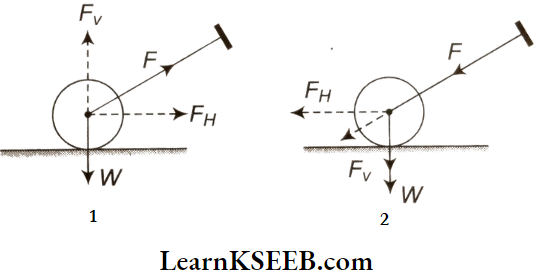
So it is easier to pull the body.
When the lawn roller is pushed by a force, the vertical component F sin θ causes the apparent increase in the weight of the object.
So the normal reaction N.R. = mg + F sin θ
∴ Frictional force [μ(mg + F sinθ)] increases and it will be difficult to pull the body.
KSEEB Class 11 Physics Chapter 5 Laws Of Motion Long Type Questions And Answers
Question 1.
- State Newton’s second law of motion. Hence, derive the equation of motion F = ma from it.
- A body is moving along a circular path such that its speed always remains constant. Should there be a force acting on the body?
Answer:
1. Newton’s 2nd law: The rate of change of momentum of a body is proportional to external force and acts along the direction of force applied.
i.e., \(\frac{d p}{d t} \propto F\)
Derivation Of Equation F = ma: According to Newton’s 2nd law.
We know \(\frac{\mathrm{dp}}{\mathrm{dt}} \propto \vec{\mathrm{F}} \Rightarrow \mathrm{F}=\mathrm{k} \cdot \frac{\mathrm{d} \overline{\mathrm{p}}}{\mathrm{dt}}\)…..(1)
But \(\vec{p}\) = momentum of the body = m \(\bar{v}\)
∴ F = \(\mathrm{k} \cdot \frac{\mathrm{d}}{\mathrm{dt}}(\mathrm{m} \overline{\mathrm{v}}) \Rightarrow \mathrm{km} \frac{\mathrm{d} \overline{\mathrm{v}}}{\mathrm{dt}}\)……(2)
But \(\frac{\mathrm{d} \overline{\mathrm{v}}}{\mathrm{dt}}\) = Rate of change in velocity = acceleration ‘a’.
∴ F = ma…… (3)
Here, k = constant.
The proportional constant is made equal to one, by properly selecting the unit of force.
∴ F = ma.
2. Force On A Body Moving In A Circular Path: Let a body of mass ‘m’ be moving in a circular path of radius ‘r’ with constant speed.
The velocity of the body is given by the tangent drawn at that point. Since velocity is changing continuously the body will have acceleration.
So the body will experience some acceleration. This is called normal acceleration (or) centripetal acceleration.
Question 2. Define the Angle of friction and Angle of repose. Show that the angle of friction is equal to the angle of repose for a rough inclined plane.
A block of mass 4 kg is resting on a rough horizontal plane and is about to move when a horizontal force of 30 N is applied to it. If g = 10 m/s². Find the total contact force exerted by the plane on the block.
Answer:
Angle Of Friction: The angle made by the resultant of the Normal reaction and the limiting friction with the Normal reaction is called the angle of friction (ø).
Angle Of Repose: Let a body of mass m is placed on a rough inclined plane. Let the angle with the horizontal ‘θ’ be gradually increased then for a particular angle of inclination (say a) the body will just slide down without acceleration.
This angle θ = α is called the angle of repose. At this stage, the forces acting on the body are in equilibrium
Equation For Angle Of Repose: Force acting on the body in a vertically downward direction = W = mg.
By resolving this force into two components.
- Force acting along the inclined plane in a downward direction = mg sinθ.
- This component is responsible for downward motion.
- The component mg cos θ. which is balanced by the normal reaction.
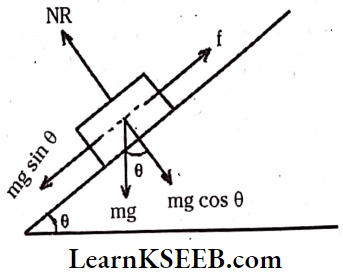
If the body slides down without acceleration resultant force on the body is zero, then
mg sin θ = Frictional force (fk)
mg cos θ = Normal reaction (N.R.)
But coefficient friction \(\mu_{\mathrm{k}}=\frac{\mathrm{f}_{\mathrm{k}}}{\mathrm{N} \cdot \mathrm{R}}=\frac{\mathrm{mg} \sin \theta}{\mathrm{mg} \cos \theta}=\tan \theta\)
Hence θ = α is called the angle of repose.
∴ μk = tan α
Hence tangent of the angle of repose (tan θ) is equal to the coefficient of friction (fk) between the bodies.
2. Given m = 4 kg
g = 10 m/s²
Normal reaction N = mg
N = 4 x 10 = 40 N
Horizontal frictional force f = 30 N
Total contact force \(\mathrm{F}=\sqrt{\mathrm{f}^2+\mathrm{N}^2}\)
F = \(\sqrt{30^2+40^2}\)
F = \(\sqrt{900+1600}\)
F = \(\sqrt{2500}\)
∴ F = 50 N

Chapter 5 Solutions For Laws Of Motion KSEEB Physics Problems
Question 1. The linear momentum of a particle as a function of time is given by, p = a + bt, where a and b are positive constants. What is the force acting on the particle?
Solution:
Linear momentum of a particle, p = a + bt
We know that force acting on a particle is equal to the rate of change of linear momentum.
i.e., \(\vec{F}=\frac{d p}{d t} \Rightarrow \vec{F}=\frac{d}{d t}(a+b t)\)
⇒ \(\vec{F}=\frac{d}{d t}(b t)=b \frac{d}{d t}=b \times 1=b\)
Question 2. Calculate the time needed for a net force of 5 N to change the velocity of a 10 kg mass by 2 m/s.
Solution:
Force, F = 5N
Change in velocity, v – u = 2ms-1
Mass, m = 10 kg
From Newton’s second law of motion,
F = \(m a=m \frac{(v-u)}{t}\)
∴ t = \(\frac{\mathrm{m}(\mathrm{v}-\mathrm{u})}{\mathrm{F}}=\frac{10 \times 2}{5}=4 \mathrm{~s}\)
KSEEB Class 11 Physics Laws of Motion Solutions
Question 3. A ball of mass ‘m’ is thrown vertically upward from the ground and reaches a height ‘h’ before momentarily coming to rest, If ‘g’ is the acceleration due to gravity. What is the impulse received by the ball due to gravity force during its flight? (neglect air resistance)
Solution:
Impulse, J = force x time
⇒ J = \(\mathrm{ma} \times \frac{2 \mathrm{u}}{\mathrm{g}}\);
Here, a = g and \(\mathrm{u}=\sqrt{2 \mathrm{gh}}\)
Now \(\mathrm{J}=\mathrm{mg} \times \frac{2 \times \sqrt{2 \mathrm{gh}}}{\mathrm{g}} \Rightarrow \mathrm{J}=2 \mathrm{~m} \sqrt{2 \mathrm{gh}}\)
∴ Impulse \(\mathrm{J}=\sqrt{8 \mathrm{~m}^2 \mathrm{gh}}\)
KSEEB Physics Laws of Motion Questions And Answers
Question 4. A constant force acting on a body of mass 3.0 kg changes its speed from 2.0 m s-1 to 3.5 m s-1 in 25 s. The direction of motion of the body remains unchanged. What is the magnitude and direction of the force?
Answer:
Mass of the body, m = 3.0 kg
The initial velocity of the body, u = 2.0 ms-1
The final velocity of the body, v = 3.5 ms-1
Time, t = 25 s
From Newton’s second law of motion,
F = \(\mathrm{ma}=\frac{\mathrm{m}(\mathrm{v}-\mathrm{u})}{\mathrm{t}}=\frac{3.0(3.5-2.0)}{25}=0.18 \mathrm{~N}\)
∴ Magnitude of force acting on the body, F = 0.18 N. The direction of force acting on the body is along the direction of motion of the body because force is positive.
Question 5. A man in a lift feels an apparent weight W when the lift is moving up with a uniform acceleration of 1/3rd of the acceleration due to gravity. If the same man was in the same lift now moving down with a uniform acceleration that is 1/2 of the acceleration due to gravity, then what is his| apparent weight?
Solution:
Case (1): When Lift Is Moving Upwards:
The apparent weight of the man = W
Acceleration, a = g/3
The apparent weight of the man, when the lift is moving upwards, is,
W = \(\mathrm{m}(\mathrm{a}+\mathrm{g})=\mathrm{m}\left(\frac{\mathrm{g}}{3}+\mathrm{g}\right) \)
= \(\frac{4}{3} \mathrm{mg}=\frac{4}{3} \mathrm{~N}\) (because \(\mathrm{N}=\mathrm{mg}\))
∴ \(\mathrm{N}=\frac{3}{4} \mathrm{~W}\)
Case (2): When the lift is moving downwards: Let W’ be (lie apparent weight of the man Acceleration, a = g/2
The apparent weight of the man when the lift is moving downwards is, W” = m(g – a) = m (g – g/2)
= \(\frac{1}{2}\) mg = \(\frac{N}{2}\) [N = mg]
= \(\frac{1}{2}\)(\(\frac{3}{4}\) W) = \(\frac{3}{8}\) W
Question 6. A container of mass 200 kg rests on the back of an open truck. If the truck accelerates at 1.5 m/s², what is the minimum coefficient of static friction between the container and the bed of the truck required to prevent the container from sliding off the back of the truck?
Solution:
Mass of the container, m = 200 kg
Acceleration of truck, a = 1.5 ms-2
Coefficient of static friction, us = \(\frac{a}{g}\)
= \(\frac{1.5}{9.8}\) = 0.153
Question 7. A bomb initially at rest at a height of 40 m above the ground suddenly explodes into two identical fragments. One of them starts moving vertically downwards with an initial speed of 10 m/s. If acceleration due to gravity is 10m/s², what is the separation between the fragments 2s after the explosion?
Solution:
Case (1): (for a downward-moving fragment)
Initial velocity, u = 10 ms-1
Acceleration, a = +g = 10 ms-1
Time, t = 2s
From the equation of motion, s = ut + \(\frac{1}{2}\) at² the distance moved in downward direction is,
s1 = 10 x 2 + \(\frac{1}{2}\) x 10 x (2)² = 40
Case (2) (For Upward Moving Fragment) Given that two fragments are identical hence, after explosion, the fragments move in opposite directions.
Here the first fragment moves in a downward direction, hence, the second fragment moves upward direction.
Again from s = ut + \(\frac{1}{2}\) at² we can write,
s2 = – 10 x 2+ \(\frac{1}{2}\) x 10 x 4 =-20 + 20 = 0 m
Separation between the fragments 2s after the explosion = s1 – s2 = 40 – 0 = 40m
Question 8. A fixed pulley with a smooth grove has a light string passing over it with a 4 kg attached on one side and a 3 kg on the other side. Another 3 kg is hung from the other 3 kg as shown with another light string. If the system is released horn rest, find the common acceleration. (g = 10 m/s²)
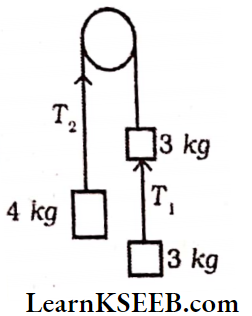
Solution:
Here, m1 = 3 + 3 = 6 kg; m2 = 4 kg; g = 10 ms-2
Acceleration of the system, \(a=\left(\frac{m_1-m_2}{m_1+m_2}\right) g \Rightarrow a=\left(\frac{6-4}{6+4}\right) \times 10=2 \mathrm{~ms}^{-2}\)
Question 9. A block of mass of 2 kg slides on an inclined plane that makes an angle of 30° with the horizontal. The coefficient of friction between the block and the surface is √3/2
- What force should be applied to the block so that it moves down without any acceleration?
- What force should be applied to the block so that it moves up without any acceleration?
Solution:
Mass of the block, m = 2kg
The angle of Inclination, θ = 30°
Coefficient of friction between the block and the surface, \(\mu=\frac{\sqrt{3}}{2}\)
1. The required force to move the block down without acceleration is,
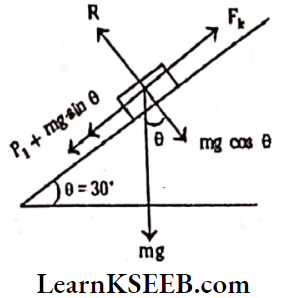
F = \(\mathrm{mg}\left(\sin \theta-\mu_{\mathrm{k}} \cos \theta\right)\)
= \(2 \times 9.8\left(\sin 30^{\circ}-\frac{\sqrt{3}}{2} \times \cos 30^{\circ}\right)\)
= \(2 \times 9.8\left(\frac{1}{2}-\frac{\sqrt{3}}{2} \times \frac{\sqrt{3}}{2}\right)=4.9 \mathrm{~N}\)
2. The required force to move the block up without any acceleration is,
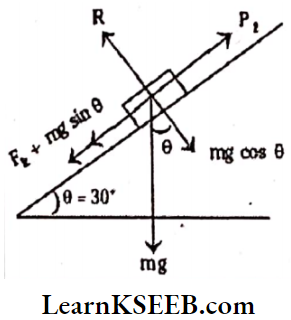
F = \(\mathrm{mg}\left(\sin \theta+\mu_{\mathrm{k}} \cos \theta\right)\)
= \(2 \times 9.8\left(\sin 30^{\circ}+\frac{\sqrt{3}}{2} \cos 30^{\circ}\right)\)
= \(2 \times 9.8\left(\frac{1}{2}+\frac{\sqrt{3}}{2} \times \frac{\sqrt{3}}{2}\right)=24.5 \mathrm{~N}\)
KSEEB 1st PUC Physics Chapter 5 Important Questions
Question 10. A block is placed on a ramp of parabolic shape given by the equation y = x²/20, see Figure.
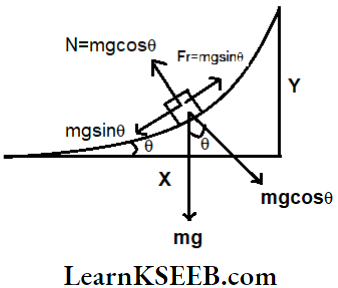
If μs = 0.5, what is the maximum height I above the ground at which the block can be placed without slipping? \(\left(\tan \theta=\mu_{\mathrm{s}}=\frac{d y}{d x}\right)\)
Solution:
For the body not to drop
mg cos θ = μ mg sin θ
⇒ tan θ = μ given μ = 0.5
.
But tan θ = \(\frac{dy}{dx}\) slope of parabolic region
⇒ \(\frac{\mathrm{dy}}{\mathrm{dx}}=\mu=0.5\)…..(1)
given \(\mathrm{y}=\frac{\mathrm{x}^2}{20}\)
∴ \(\frac{\mathrm{dy}}{\mathrm{dx}}=\frac{2 \mathrm{x}}{20}=\cdot \frac{\mathrm{x}}{10}\)…..(2)
∴ slope \(\frac{\mathrm{y}}{\mathrm{x}}=0.5 \Rightarrow 0.5=\frac{\mathrm{x}}{10} \Rightarrow \mathrm{x}=5\)…..(3)
From eq. (1) and (3) vertical height, y = \(\frac{x^2}{20}=\frac{5 \times 5}{20}=1.25 \mathrm{~m}\)
Question 11. A block of metal of mass 2 kg on a horizo¬ntal table is attached to a mass of 0.45 kg by a light string passing over a frictionless pulley at the edge of the table. The block is subjected to a horizontal force by allowing the 0.45 kg mass to fall. The coefficient of sliding friction between the block and the table is 0.2. Calculate
- The initial acceleration,
- The tension in the string,
- The distance the block would continue to move if, after 2 s of motion, the string should break.
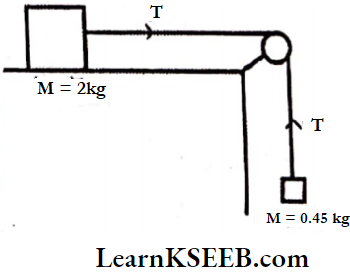
Solution:
Mass of the first block, m1 = 0.45 kg
Mass of the second block, m2 = 2kg
coefficient of sliding friction between the block and table, μ = 0.2
1. Initial acceleration, \(a=\left(\frac{m_1-\mu m_2}{m_1+m_2}\right) g\)
⇒ a = \(\left(\frac{0.45-0.2 \times 2}{0.45+2}\right) \times 9.8\)
⇒ a = \(0.2 \mathrm{~ms}^{-2}\)
2. Tension in the string
T = \(\frac{\left(\mathrm{m}_1+\mu \mathrm{m}_2\right) g+\left(\mathrm{m}_2-\mathrm{m}_1\right) \mathrm{a}}{2}\)
T = \(\frac{(0.45+0.2 \times 2) 9.8+(2-0.45) 0.2}{2}\)
= \(\frac{(0.85 \times 9.8)+(1.55 \times 0.2)}{2}\)
T = \(\frac{8.33+0.31}{2}=\frac{8.64}{2}=4.32\) Newton
3. Velocity of string after 2 sec=u in this case; \(\mathrm{u}^{\prime}=0\)
∴ \(\mathrm{u}=\mathrm{u}^{\prime}+\mathrm{at}=0+0.2 \times 2=0.4 \mathrm{~m} / \mathrm{s}\)
Stopping distance, \(\mathrm{s}=\frac{\mathrm{u}^2}{2 \mu \mathrm{g}}\)
= \(\frac{0.4 \times 0.4}{2 \times 0.2 \times 9.8}=\frac{0.4}{9.8}=0.0408 \mathrm{~m}\)
or \(\mathrm{s} \simeq 4.1 \mathrm{~cm}\)
Question 12. On a smooth horizontal surface a block A of mass 10 kg is kept. On this block, a second block B of mass 5 kg is kept. The coefficient of friction between the two blocks is 0.4. A horizontal force of 30 N is applied on the lower block as shown. The force of friction between the blocks is (take g = 10 m/s²)
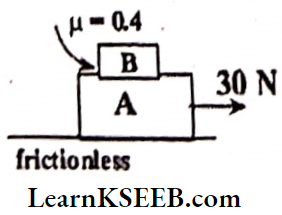
Solution:
The mass of block ‘A’ is mA = 10 kg
The mass of block ‘B’ is mB = 5 kg
Applied horizontal force, F = 30 N
Coefficient of friction between two blocks, μ = 0.4
The frictional force of block ’B’ Is f = μ mg
⇒ f = 0,4 x 5 x 10 = 20N
∴ The frictional force acting between the two blocks, = F – f = 30 – 20 = 10N
Question 13. A batsman hits back a ball straight in the direction of the bowler without changing its initial speed of 12 ms-1. If the mass of the ball is 0.15 kg, determine the impulse imparted to the ball. (Assume linear motion of the ball).
Solution:
Impulse = change in momentum = (0.15 x 12)-(-0.15 x 12) = 3.6 NS .
In the direction from the batsman to the bowler.
Question 14. A force 2\(\bar{i}\) + \(\bar{j}\) — \(\bar{k}\) Newton acts on a body which is initially at rest. At the end of 20 seconds the velocity of the body is 4\(\bar{i}\) + 2\(\bar{j}\) – 2\(\bar{k}\) m/s. What is the mass of the body?
Solution:
Force F = 2\(\bar{i}\) + \(\bar{j}\) – \(\bar{k}\) = 20sec
Initial velocity u0 = 0.
Final velocity U = 4\(\bar{i}\) + 2\(\bar{j}\) – 2\(\bar{k}\)
Mass of the body m = \(\frac{F}{a}\)
But acceleration \(a=\frac{U-U_0}{t}\)
∴ \(\mathrm{m}=\frac{\text { F.t }}{\mathrm{U}-\mathrm{U}_0}=\frac{20 \cdot|\mathrm{F}|}{\left|\mathrm{U}-\mathrm{U}_0\right|}\)
= \(\frac{20 \sqrt{2^2+1+1}}{\sqrt{4^2+2^2+2^2}-0}=\frac{20 \sqrt{6}}{\sqrt{24}}\)
∴ \(\mathrm{m}=\frac{20 \sqrt{6}}{\sqrt{4 \times 6}}=\frac{20 \sqrt{6}}{2 \sqrt{6}}=10 \mathrm{~kg} \text {. }\)
Question 15. A constant retarding force of 50 N is applied to a body of mass 20 kg moving initially with a speed of 15 ms-1. How long does the body take to stop?
Solution:
Here, F = – 50N, m = 20 kg
u = 15 ms-1, v = 0, t = ?
From F = \(m a, a=\frac{F}{m}=\frac{-50}{20}=-2.5 \mathrm{~ms}^{-2}\)
From \(\mathrm{v}=\mathrm{u}+\mathrm{at} ; 0=15-2.5 \mathrm{t}\)
t = \(\frac{15}{2.5}=6 \mathrm{~s}\)
Question 16. A body of mass 5 kg is acted upon by two perpendicular forces 8 N and 6N. Give the magnitude and direction of the acceleration of the body.
Solution:
Here, m = 5 kg, \(\vec{a}\) = ?
⇒ \(\vec{F}_1=\overrightarrow{O A}=8 \mathrm{~N} ; \vec{F}_2=\overrightarrow{O B}=6 \mathrm{~N}\)
Resultant force \(\overrightarrow{\mathrm{F}}=\overrightarrow{\mathrm{OC}}=\sqrt{\mathrm{F}_1^2+\mathrm{F}_2^2}\)
= \(\sqrt{8^2+6^2}=10 \mathrm{~N}\)
If \(\angle A O C=\theta, \tan \theta=\frac{\mathrm{AC}}{\mathrm{OA}}=\frac{\mathrm{OB}}{\mathrm{OA}}=\frac{6}{8}=0.75\)
∴ \(\theta=36^{\circ} 52^{\prime}\)
This is the direction of the resultant force and hence the direction of acceleration of the body as shown.
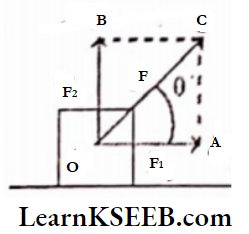
Also, \(\mathrm{a}=\frac{\mathrm{F}}{\mathrm{m}}=\frac{10}{5}=2 \mathrm{~ms}^{-2}\)
Karnataka Board Class 11 Physics Chapter 5 MCQs
Question 17. The driver of a three-wheeler moving with a speed of 36 km /h sees a child standing in the middle of the road and brings his vehicle to rest in 4.0 seconds just in time to save the child. What is the average retarding force on the vehicle? The mass of the three-wheeler is 400 kg and the mass of the driver is 65 kg.
Solution:
Here, u = 36 km/h = 10 m/s, v = 0, t = 4s
m = 400 + 65 = 465 kg
Retarding force = \(\mathrm{F}=\mathrm{ma}=\frac{\mathrm{m}(\mathrm{v}-\mathrm{u})}{\mathrm{t}}\)
= \(\frac{465(0-10)}{4}=-1162.5 \mathrm{~N}\)
Question 18. A rocket with a lift-off mass of 20,000 kg Is blasted upwards with an initial acceleration of 5.0 ms-2. Calculate the initial thrust (force) of the blast.
Solution:
Here, m = 20000 kg = 2 x 104 kg
Initial acceleration, a = 5 ms-2;
Thrust, F =?
Clearly, the thrust should be such that it overcomes the force of gravity besides giving it an upward acceleration of 5 ms-2.
Thus the force should produce a net acceleration of 9.8 + 5.0 = 14.8 ms-2.
As thrust = force = mass x acceleration
∴ F = 2 X 104 X 14.8 = 2.96 X 105 N
Question 19. A man of mass 70 kg stands on a weighing scale in a lift which is moving
- Upwards with a uniform speed of 10 ms-1,
- Downwards with a uniform acceleration of 5 ms-2,
- Upwards with a uniform acceleration of 5 m s-2, What would be the readings on the scale in each case?
- What would be the reading if the lift mechanism failed and it hurtled down freely under gravity?
Solution:
Here, m = 70 kg, g = 10 m/s²
The weighing machine in each case measures the reaction R i.e., the apparent weight.
1. When the lift moves upwards with a uniform speed, its acceleration is zero.
∴ R = mg = 70 x 10 = 700 N
2. When the lift moves downwards with a = 5 ms-2
∴ R = m(g- a) = 70 (10 – 5) = 350 N
3. When the lift moves upwards with a = 5 ms-2
∴ R = m (g + a) = 70 (10 + 5) = 1050 N
4. If the lift were to come down freely under gravity, downward acceleration. a = g
∴ R = m (g – a) = m (g – g) = Zero.
Question 20. Two bodies of masses 10 kg and 20 kg respectively kept on a smooth, horizontal surface arc tied to the ends of a light string, a horizontal force F = 000 N Is applied to
- A,
- B along the direction of hiring.
What is the tension In the string in each ease?
Solution:
Here, F = 600 N m1 = 10 kg, m2 = 20 kg
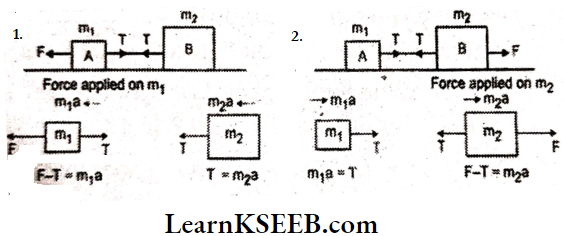
Let T be the tension in the string and a be the acceleration of the system, in the direction of force applied.
∴ a = \(\frac{F}{m_1+m_2}=\frac{600}{10+20}=20 \mathrm{~m} / \mathrm{s}^2\).
- When force is applied on lighter block A, T = m2a = 20 x 20 N = 400 N
- When force is applied on heavier block B, T = m1a = 10 x 20 N T = 200 N
Which is different from the value of T in case (1).
Hence our answer depends on which mass end, the force is applied.
Question 21. Two masses 8 kg and 12 kg are connected at the two ends of a light in an extensible string that goes over a frictionless pulley. Find the acceleration of the masses, and the tension in the string when the masses are released.
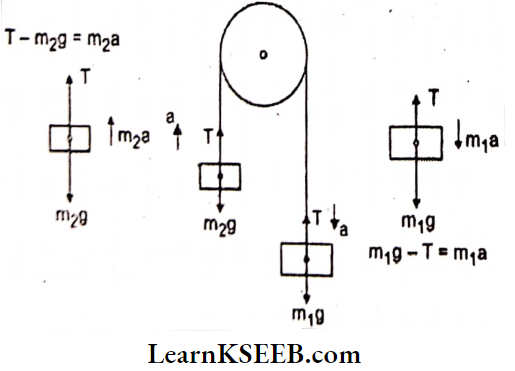
Solution:
Here, m2 = 8 kg, ; m1 = 12kg
As a = \(\frac{\left(m_1-m_2\right) g}{m_1+m_2}=\frac{(12-8) 9.8}{12+8}=\frac{39.2}{20}\) = \(1.96 \mathrm{~ms}^{-2}\)
Again, \(T=\frac{2 m_1 m_2 g}{m_1+m_2}=\frac{2 \times 12 \times 8 \times 9.8}{(12+8)}\)
= 94.1 N
Question 22. A nucleus is at rest In the laboratory frame of reference. Show that If It disintegrates Into two smaller nuclei the products must move in opposite directions.
Solution:
Let m1, m2 be the masses of products and \(\overrightarrow{v_1}, \overrightarrow{v_2}\) be their respective velocities. Therfore, total linear momentum after disinte-gration = \(m_1 \overrightarrow{v_1}+m_2 \overrightarrow{v_2}\).
Before disintegration, the nucleus is at rest. Therefore, its linear momentum before disintegration is zero.
According to the principle of conservation of linear momentum, \(m_1 \overline{v_1}+m_2 \overline{v_2}=0 \text { or } \overline{v_2}=\frac{-m_1 \overline{v_1}}{m_2}\)
Negative sign shows that \(\overrightarrow{\mathrm{v}_1} \text { and } \overrightarrow{\mathrm{v}_2}\) are in opposite directions.
Question 23. Two billiard balls each of mass 0.05 kg moving in opposite directions with a speed of 6 ms-1 collide and rebound with the same speed. What is the impulse imparted to each ball due to the other?
Solution:
Here, initial momentum of the ball A = 0.05 (6) = 0.3 kg ms-1
As the speed is reversed on collision, the final momentum of the ball A = 0.05 (-6) = – 0.3 kg ms-1
Impulse imparted to ball A = change in momentum of ball A = final momentum – initial momentum = – 0.3 – 0.3 = – 0.6 kg ms-1.
Question 24. A shell of mass 0.02 kg is fired by a gun of mass 100 kg. If the muzzle speed of the shell is 80 ms-1, what is the recoil speed of the gun?
Solution:
Here, the mass of the shell, m = 0.02 kg.
mass of gun, M = 100 kg
muzzle speed of shell, V = 80 ms-1
recoil speed of gun, v =?
According to the principle of conservation of linear momentum, mV + Mν = 0
or, \(\mathrm{v}=-\frac{\mathrm{mV}}{\mathrm{M}}=\frac{-0.02 \times 80}{100}=0.016 \mathrm{~ms}^{-1}\)
Class 11 Physics Laws of Motion KSEEB Guide
Question 25. A slone of mass 0.25 kg tied to the end of a string is whirled round in a circle of radius 1.5 ni with a speed of 40 rev./min in a horizontal plane. What is the tension in the string? What is the maximum speed with which the stone can be whirled around if the string can withstand a maximum tension of 200 N?
Solution:
Here, m = 0.25 kg, r = 1.5 m;
n = \(40 \mathrm{rpm}=\frac{40}{60} \mathrm{rps}=\frac{2}{3} \mathrm{rps}, \mathrm{T}=?\)
T = \(\mathrm{mr} \omega^2=\mathrm{mr}(2 \pi \mathrm{n})^2=4 \pi^2 \mathrm{mr} \mathrm{r}^2\)
T = \(4 \times \frac{22}{7} \times \frac{22}{7} \times 0.25 \times 1.5 \times\left(\frac{2}{3}\right)^2=6.6 \mathrm{~N}\)
If \(\mathrm{T}_{\max }=200 \mathrm{~N}\), then from \(\mathrm{T}_{\max }=\frac{\mathrm{mv}_{\max }^2}{\mathrm{r}}\)
⇒ \(\mathrm{v}_{\max }^2=\frac{\mathrm{T}_{\max } \times \mathrm{r}}{\mathrm{m}}=\frac{200 \times 1.5}{0.25}=1200\)
⇒ \(\mathrm{v}_{\max }=\sqrt{1200}=34.6 \mathrm{~m} / \mathrm{s}\)
Question 26. Explain why
- A horse cannot pull a cart and run in empty space,
- Passengers are thrown forward from their seats when a speeding bus stops suddenly,
- It is easier to pull a lawn mover than to push it,
- A cricketer moves his hands backward while holding a catch.
Solution:
- While trying to pull a cart, a horse pushes the ground backward with a certain force at an angle. The ground offers an equal reaction in the opposite direction, on the feel of the horse. The forward component of this reaction is responsible for the motion of the cart. In empty space, there Is no reaction, and hence, a horse cannot pull the cart and run.
- This is due to the “inertia of motion”. When the speeding bus stops suddenly, the lower part of the body in contact with the seats stops. The upper part of the bodies of the passengers tends to maintain a uniform motion. Hence, the passengers are thrown forward.
- While pulling a lawn mover, force is applied upwards along the handle. The vertical component of this force is upwards and reduces the effective weight of the mover. While pushing a lawn mover, force is applied downwards along the handle. The vertical component of this force is downwards and increases the effective weight of the mover. As the effective weight is lesser in the case of pulling than in the case of pushing, therefore, “pulling is easier than pushing”.
- While holding a catch, the impulse received by the hands, F x t = change in linear momentum of the ball is constant. By moving his hands backward, the cricketer increases the time of impact (t) to complete the catch. As t increases, F decreases and as a reaction, his hands are not hurt severely.
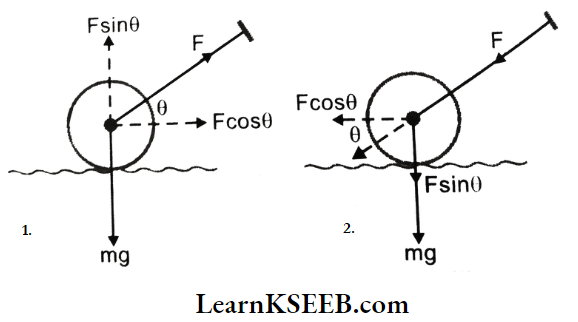
Question 27. A stream of water flowing horizontally with a speed of 15 m s-1 pushes out of a tube of cross-sectional area 10-2 m2, and hits a vertical wall nearby. What is the force exerted on the wall by the impact of water, assuming it does not rebound?
Solution:
Here, v = 15 ms-1
Area of cross-section, a = 10-2 m2
The volume of water pushing out/sec = a x v = 10-2 x 15 m3 s-1
As the density of water is 103 kg/m3, therefore, mass of water strikes the wall per sec.
m = (15 x 10-2) x 103 = 150 kg/s.
As \(\mathrm{F}=\frac{\text { change in linear momentum }}{\text { time }}\)
∴ \(\mathrm{F}=\frac{\mathrm{m} \times \mathrm{v}}{\mathrm{t}}=\frac{150 \times 15}{1}=2250 \mathrm{~N}\)
KSEEB Class 11 Physics Laws of Motion Numericals
Question 28. Ten one-rupee coins are put on top of each other on a table. Each coin has a mass of m. Give the magnitude and direction of
- The force on the 7th coin (counted from the bottom) due to all the coins on its top,
- The force on the 7th coin by the eighth coin,
- The reaction of the 6th coin on the 7th coin.
Solution:
1. The force on the 7th coin is due to the weight of the three coins lying above it. Therefore, F = (3 m) kgf = (3 mg) N
where g is the acceleration due to gravity. This force acts vertically downwards.
2. The eighth coin is already under the weight of two coins above it and it has its own weight too. Hence force on 7th coin due to 8th coin is sum of the two forces i.e. F = 2 m + m = (3 m) kgf = (3 mg) N
The force acts vertically downwards.
3. The sixth coin is under the weight of four coins above it.
Reaction, r = -F = -4 m (kgf) =- (4 mg) N
The Minus sign indicates that the reaction acts vertically upwards, opposite to the weight.
Question 29. An aircraft executes a horizontal loop at a speed of 720 km/h with its wings banked at 15°. What is the radius of the loop?
Solution:
Here θ = 15°
v \(=720 \mathrm{~km} / \mathrm{h}=\frac{720 \times 1000}{60 \times 60}=200 \mathrm{~ms}^{-1}\);
g = \(9.8 \mathrm{~ms}^{-2} \text {; from } \tan \theta=\frac{\mathrm{v}^2}{\mathrm{rg}} \)
⇒ \(\mathrm{v}^2=\mathrm{rg} \tan \theta\)
∴ r \(=\frac{\mathrm{v}^2}{\mathrm{~g} \tan \theta}=\frac{(200)^2}{9.8 \times \tan 15^{\circ}}\)
= \(15232. \mathrm{m}=15.232 \mathrm{k} \cdot \mathrm{m} \text {. }\)
Question 30. A train runs along an unbanked circular track of radius 30 m at a speed of 54 km/h The mass of the train is 106 kg. What provides the centripetal force required for, this purpose-The engine or the rails? What is the angle of banking required to prevent wearing out of the rail?
Solution:
The centripetal force is provided by the lateral thrust exerted by the rails on the wheels. By Newton’s 3rd law, the train exerts an equal and opposite thrust on the rails causing its wear and tear.
Obviously, the outer rail will wear out faster due to the larger force exerted by the train on it.
Here, \(v=54 \mathrm{~km} / \mathrm{h}=\frac{54 \times 1000}{60 \times 60}=15 \mathrm{~m} / \mathrm{s}\);
g = \(9.8 \mathrm{~ms}^{-2}\)
As \(\tan \theta=\frac{\mathrm{v}^2}{\mathrm{rg}}=\frac{15 \times 15}{30 \times 9.8}=0.76 ;\)
∴ \(\theta=\tan ^{-1} 0.76=37.4^{\circ}\)
Question 31. A block of mass 25 kg Is raised by a 50 kg man in two different ways as shown. What Is the action on the floor by the man in the two cases? If the floor yields to a normal force of 700 N, which mode should the man adopt to lift the block without the floor yielding?
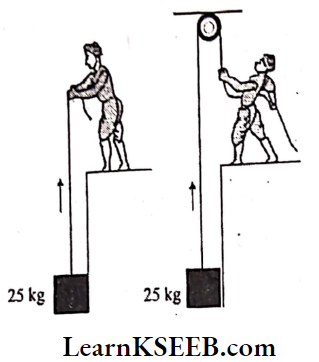
Solution:
Here, the mass of the block, m = 25 kg
Mass of man, M = 50 kg
Force applied to lift the block
F = mg = 25 x 9.8 = 245 N
Weight of man W = Mg = 50 x 9.8 = 490 N
1. When a block is raised by the man as shown, force is applied by the man in the upward direction. This increases the apparent weight of the man. Hence action on the floor.
W’ = W + F = 490 + 245 = 735 N
When a block is raised by a man as shown, force is applied by the man in the downward direction. This decreases the apparent weight of the man. Hence, action on the floor in this case would be W’ = W – F = 490 – 245 = 245 N.
As the floor yields to a normal force of 700 N, mode (2) has to be adopted by the man to lift the block.
Question 32. A monkey of mass 40 kg climbs on a rope that can stand a maximum tension of 600 N. In which of the following cases will the rope break the monkey
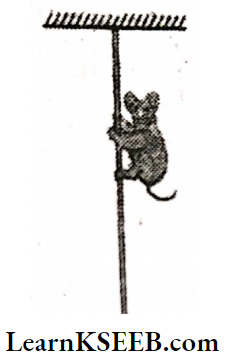
- Climbs up with an acceleration of 6 ms-2
- Climbs down with an acceleration of 4 ms-2
- Climbs up with a uniform speed of 5 ms-1
- Fell down the rope nearly freely under gravity?
(Ignore the mass of the rope).
Solution:
Here, the mass of the monkey, m = 40 kg.
Maximum tension the rope can stand, T = 600 N.
In each case, the actual tension in the rope will be equal to the apparent weight of the monkey (R),
The rope will break when R exceeds T.
1. When monkey climbs up with a = 6 ms-2, R = m (g + a) = 40 (10 + 6) = 640 N (which is greater than T).
Hence the rope will break.
2. When the monkey climbs down with a = 4 ms-2
R = m (g – a) = 40 (10 – 4) = 240 N, which is less than T
∴ The rope will not break.
3. When the monkey climbs up with a uniform speed v = 5 ms-1,
its acceleration a = 0
R = mg = 40 x 10 = 400 N, which is less than T
∴ The rope will not break.
4. When the monkey falls down the rope nearly freely under gravity, a = g
R = m (g – a) = m (g – g) = 0 (Zero.)
Hence the rope will not break.
Question 33. A 70 kg man stands In contact against the Inner wall of a hollow cylindrical drum of radius 3 m rotating about its vertical avis with 200 rev/mln. The coefficient of friction between the wall and his clothing is 0.15. What is the minimum rotational speed of the cylinder to enable the man to remain stuck to the wall (without falling) when the floor is suddenly removed?
Solution:
Here, m = 70 kg, r = 3 m
n = 200, rpm = \(\frac{200}{60}\) rps, μ = 0.15, ω= ?
The horizontal force N by the wall on the man provides the necessary centripetal force = m r ω². The frictional force (f) in this case is vertically upwards opposing the weight (mg) of the man.
After the floor is removed, the man will remain stuck to the wall, when mg = f < μ N, i.e. mg < μ m r ω² or g < μ r ω²
∴ The minimum angular speed of rotation of the cylinder is \(\omega=\sqrt{\frac{g}{\mu r}}=\sqrt{\frac{10}{0.15 \times 3}}\)
= \(4.7 \mathrm{rad} / \mathrm{s}\)
Question 34. A thin circular loop of radius R rotates about its vertical diameter with an angular frequency ω. Show that a small bead on the wire loop remains at its lowermost point for \(\omega \leq \sqrt{g / R},\). What is the angle made by the radius vector joining the center to the bead with the vertically downward direction form = \(\omega \leq \sqrt{2g / R},\) Neglect friction?
Solution:
In Figure, we have shown that the radius vector joining the bead to the center of the wire makes an angle 0 with the verticle downward direction. If N is a normal reaction, then as is clear from the figure,
⇒ \(\mathrm{mg}=\mathrm{N} \cos \theta\)….(1)
⇒ \(\mathrm{mr} \omega^2=\mathrm{N} \sin \theta\)…..(2)
or \(\mathrm{m}(\mathrm{R} \sin \theta) \omega^2=\mathrm{N} \sin \theta \text { or } \mathrm{m} \mathrm{R}^2=\mathrm{N}\)
from (1), \(\mathrm{mg}=\mathrm{m} R \omega^2 \cos \theta\)
or \(\cos \theta=\frac{\mathrm{g}}{\mathrm{R \omega}^2}\) …..(3)
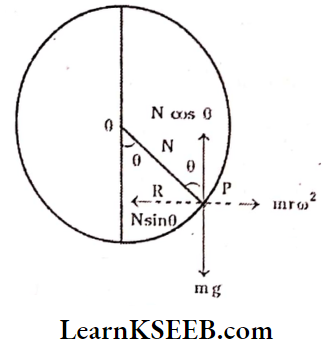
As |cos θ| ≤ 1, therefore, the bead will remain at its
lowermost point for \(\frac{g}{R \omega^2} \leq 1 \text {, or } \omega \leq \sqrt{\frac{g}{R}}\)
When \(\omega=\sqrt{\frac{2 g}{R}}\) from (3), \(\cos\theta=\frac{g}{R}\left(\frac{R}{2 g}\right)=\frac{1}{2}\)
∴ \(\theta=60^{\circ}\)
